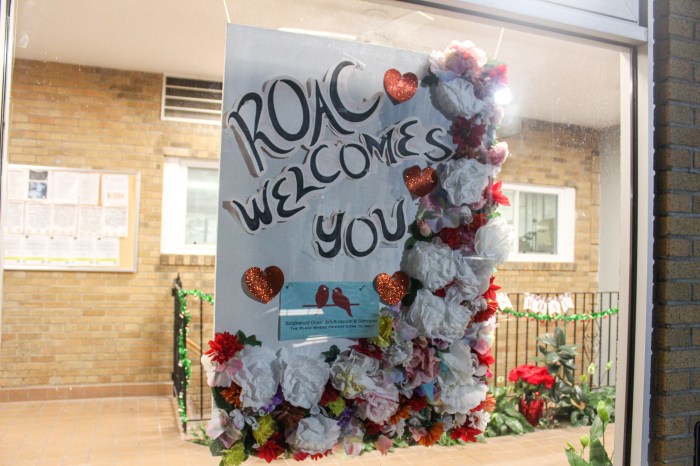By Raphael Sugarman
“Little Women” is not a flight of Alcott's imagination. It is a fictionalized account of the days she spent with her three flesh and blood sisters and her parents in the rural township of Concord and Boston, Mass. The familial celebrations and sorrow depicted on the pages of the novel were born of real life events in the lives of Alcott's real sisters Lizzie, Anna, and May. For Queens actors Amy McAlexander and Anne Kanengeiser, both of whom are involved in the newly launched “Little Women,” the musical, the story of the March sisters is no less poignant and personal. McAlexander, a 27-year-old Houston native who lives in Astoria, plays Amy, the youngest and perhaps most emotionally complex of all the March girls. “This character is me,”said McAlexander, who describes herself and the character Amy March as “little sprites, little wood creatures.” “My God. I love her. I know exactly where she is coming from.”Kanengeiser, who lives in Long Island City and traces at least two generations of theatrical roots back to Columbus, Ohio, is standing by for the plum role of Marmee, the family matriarch, being played by Maureen McGovern. The youngest of three sisters in a family troubled by alcoholism and illness, Kanengeiser, has an intimate understanding of loss and longing, and of Marmee's stiff upper lip in times of distress.”I pursued this role from the moment I first read the script,” said Kanengeiser, on a recent Saturday, when she stood in for McGovern for both the matinee and evening performances. “I was able to go to Marmee's emotional places because I know those places.”A family odysseyIt seems impossible to tell the tale of any one character in “Little Women” without relating it to her sisters and family history. So, too, the story of Anne Kanengeiser. A self-described “old-school actor,” Kanengeiser jokes that she came out of her mother's womb dancing. Suzanne, or “Susie,” Kanengeiser was a dancer who longed to make it to Broadway. Anne's father Robert was an engineer who built stage sets and her grandmother, Elsie Kittle, was a director and performer in Columbus' literary and theatrical communities. Kittle taught Shakespeare at Ohio State University and in her youth, toured with the renowned Circuit Chautauqua.Although her upbringing was sometimes dysfunctional, the Kanengeiser house was always filled with music: Tchaikovsky and Roger Miller, Rachmaninoff and Rogers and Hammerstein. Dance was Anne's first calling. But by the age of 11, her desire to find a personal art form unique from her talented mother, gave voice to a new interest.”One night, I just jumped up on the dishwasher in my family's kitchen and started singing,” she recalled with a chuckle. “I exclaimed that I wanted to be a singer.”She honed her singing and acting skills during high school and, after attending Ohio's Otterbein College, moved to Chicago to pursue her career. Kanengeiser's first big break came in the winter of 1995 when she was cast as a young Eleanor Roosevelt in “Eleanor: An American Love Story.” Playing Eleanor allowed Kanengeiser to draw upon her own nature: Nurturing and patrician in the face of personal sadness. Exactly a decade later, she would summon the same emotional reservoir to play “Little Women's” Marmee, a character eerily similar to Eleanor.She played Fosca in the first regional production of “Passion,” at the Signature Theatre, Va., in the spring of 1996. The part earned her the Helen Hayes Award for Best Actress. She won the award again in 2000 for a revival of her role as Eleanor.Kanengeiser's first role on Broadway was in the 1997 production of “Ragtime.” She also played the role of Mrs. Potts in the national tour of “Beauty and the Beast.” Though she is only scheduled to play Marmee a few times in the first few months of “Little Women's” run – on March 18 and April 14-17 – she said the part resonates with her. She dedicates her appearances as Marmee to her own sisters, Judith, and Ani Drolkar, a Tibetan Buddhist nun, “with love and gratitude.”Living with Amy Like a lot of girls, Amy McAlexander can remember reading “Little Women” over and over, growing up in Houston and Alaska. But few young fans of Louisa May Alcott's novel could relate as closely to a specific character as McAlexander did to her literary namesake, Amy March, who like her is talented, insecure and a bit mischievous. “I really loved Amy from the very beginning, from the first time I read the book,” McAlexander said in an interview following a recent performance. “I thought, 'wow, this is really me.'”Born much later than her only sibling, a brother, McAlexander admits to “having been a bit bratty as a child.””I threw tantrums once in a while, like Amy,” she said. “That's why I understand exactly where she is coming from.”Unlike the fictitious Amy, however, McAlexander's gifts were evident at a very young age. She started singing at age 3 and played 12 years of classical piano. By the seventh grade she had landed her first role in a play and by 10th grade was playing Irma in “Anything Goes.”She attended the High School for Visual and Performing Arts, and, like Kanengeiser, graduated Otterbein College. She played in “Enter the Guardsman” for the San Jose Reparatory Theatre, “Damn Yankees” at the Utah Shakespeare Festival and “Flim Flam” at the York Theatre, before moving to New York five years ago. McAlexander said that struggling to find work as an actor since her arrival has had an incalculable impact on her confidence. But it doesn't take much prodding for her to reveal that she has long had self-esteem issues. “If I were six-foot-five, I wouldn't be the same person, I wouldn't feel the same,” said the diminutive actress. It can't be easy for an accomplished 27-year old to be cast as the rather annoying youngest sibling of three formidable sisters: Jo the dynamo, comely Meg, and angelic Beth. Amy March is the closest thing that “Little Women” has to an antagonist. When she spitefully tosses her sister Jo's story into the fire after not being invited to the big dance, the audience feels more anger towards Amy, perhaps, than pity. Eliciting this complex reaction from theater-goers is a credit to McAlexander's acting skills. But she can't help feeling empathy and even a little sadness towards Amy.”It always hurts me to stand in the wings and listen to the audience's pleasure when Jo calls Amy the devil,” said McAlexander. “I want to scream out 'can't you see that she hurts, that she is in pain?'”Little no moreThough they are a generation apart in age, were raised in different parts of the country and play diametrically opposite characters in this musical, Kanengeiser and McAlexander feel a kinship towards one another. “She looks at the world the same way that I do,” said McAlexander. “That everything has a purpose and everything happens for a reason.”This view of life makes them ideally suited for a musical set in uncertain times and filled with pathos and longing; a story about change in the midst of stability and stability in the midst of change.In one of the most heartrending scenes in the production, Kanengeiser's character, Marmee, is consoling her distraught youngest daughter, promising “Amy, your time will come.” Amy is skeptical, but by the middle of the final act, she has transformed herself into a woman, discovering love and her talents as an artist. Marmee has also changed. No longer eternally stoic, she allows those closest to her to see her vulnerable, fearful side. Kanengeiser and McAlexander have also evolved. And though they – like the sisters March – are still unclear about the future, they begrudgingly sense that their time too has come. “Like the characters in 'Little Women,' I have finally healed the part of me that needed healing,” said Kanengeiser. “There is a particular strength and intensity that comes from having the kind of life that we all had.””Little Women” the musical is playing at the Virginia Theatre on West 52nd Street.





























